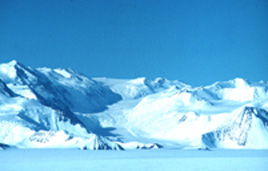Belle Dumas, Physics Web

Direct address to this page:
https://www.hayadan.org.il/cosmicglacier0704.html
Three physicists claim that changes in the showers of cosmic rays, which hit the earth, may cause ice ages. Jasper Kirkby (Kirkby) from CERN, Augusto Mangini (Mangini) from the University of Heidelberg and Richard Muller (Muller) from the University of California at Berkeley claim that cosmic rays cause changes by affecting clouds. The physicists, who challenge the accepted theory of the cycles of the glaciers' exposure to the sun, are expected to encounter a lot of resistance from the geophysicist community.
Kirkby and his colleagues presented new information regarding the fluxes of cosmic radiation that hit the Earth. The information comes from the beryllium-10 content of sediments in the deep ocean. The researchers say that according to the information there is a connection between the cycle of the glaciers and the amount of cosmic radiation reaching the earth. The beryllium-10 isotope is created when there is an interaction between cosmic rays and the particles in the earth's atmosphere. After it is formed, the beryllium falls to the ground and is trapped in ice or sediments in the ocean.
The possible connections between cosmic radiation and glacier cycles follows a previous study, which linked cosmic radiation and climate change. In 1997, Henrik Svensmark (Svensmark) and Egil Friss-Christensen (Friss-Christensen) from the Danish Space Research Institute put forward the suggestion that a large amount of cosmic radiation fluxes may lead to the creation of more clouds and a colder and opposite climate. The Danish scientists claimed that changes in the strength of the solar wind - the stream of charged particles flowing to us from the sun - may lead to changes in the fluxes of cosmic radiation.
Kirkby and his colleagues presented two mechanisms by which cosmic radiation fluxes may change. The first is changes in the earth's geodynamo, which cause changes in the direction and strength of the earth's magnetic field. Such an effect was recently discovered in long-term measurements of the geomagnetic field. Also, say Kirkby and his colleagues, evidence of the effect can be seen in the data obtained from beryllium-10. Measurements of stalagmites in northern Oman and the Austrian Alps provide further support for this hypothesis.
"The proposed idea is controversial but not completely crazy," says Peter Thejll of the Danish Meteorological Institute. "I think it's worth discussing."
The accepted model of the cycles of solar exposure to glaciers was first proposed by the Serbian astrophysicist Milotin Milankovitch in 1912. Milankovitch claimed that the ice ages were caused by changes in the amount of sunlight that reaches the Earth, and that the ice ages are associated with gradual cycles in the shape of its orbit of the earth around the sun. However, despite the model's ability to explain a 41-kilo-year ice cycle seen in the paleoclimate data record, it additionally predicts the existence of a 400-kilo-year cycle, which has not been discovered. Also, the model lacks the ability to explain a 100-year cycle, as it was discovered.
Translation: Dikla Oren
The article on Physics Web
Idan Earth - the stalwarts of nature
https://www.hayadan.org.il/BuildaGate4/general2/data_card.php?Cat=~~~897433488~~~138&SiteName=hayadan
